
The orange-headed thrush is a bird in the thrush family.

White's thrush is a member of the thrush family, Turdidae. It was named after the English naturalist Gilbert White. The genus name Zoothera comes from the Ancient Greek zoon, "animal" and theras, "hunter". The specific aurea is from Latin aureus, "golden".
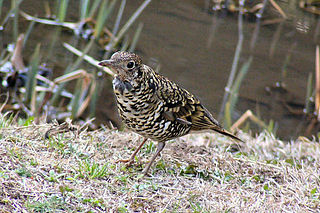
The Asian thrushes are medium-sized mostly insectivorous or omnivorous birds in the genus Zoothera of the thrush family, Turdidae.

The golden-fronted leafbird is a species of leafbird. It is found from the Indian subcontinent and south-western China, to south-east Asia and Sumatra.
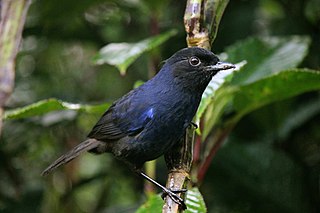
The Sri Lanka whistling thrush is a whistling thrush in the family Muscicapidae. It is a resident endemic bird in Sri Lanka.

The hill swallow is a small passerine bird in the swallow family. It breeds in southern India and Sri Lanka. It is resident apart from some local seasonal movements. This bird is associated with coasts, but is increasingly spreading to forested uplands. It was formerly considered to be a subspecies of the Pacific swallow.

The pied thrush is a member of the thrush family found in India and Sri Lanka. The males are conspicuously patterned in black and white while the females are olive brown and speckled. They breed in the central Himalayan forests and winter in the hill forests of southern India and Sri Lanka. Like many other thrushes, they forage on leaf litter below forest undergrowth and fly into trees when disturbed and sit still making them difficult to locate.
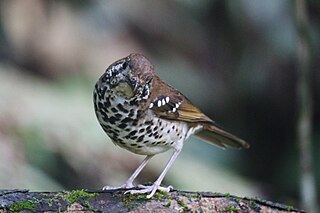
The spot-winged thrush,, is an Asian thrush, a group within the large thrush family Turdidae.
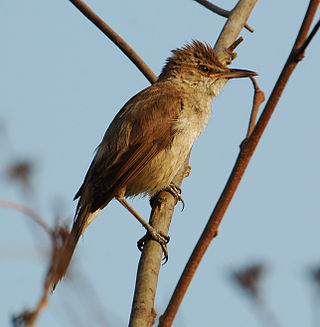
The clamorous reed warbler is an Old World warbler in the genus Acrocephalus. It breeds from Egypt eastwards through Pakistan, Afghanistan and northernmost India to south China and southeast Asia. A. s. meridionalis is an endemic race in Sri Lanka.

The crested goshawk is a bird of prey from tropical Asia. It is related to other diurnal raptors such as eagles, buzzards and harriers, and thus placed in the family Accipitridae.

The black-headed ibis, also known as the Oriental white ibis, Indian white ibis, and black-necked ibis, is a species of wading bird of the ibis family Threskiornithidae which breeds in the South and Southeast Asia from India to the west and as far east as Japan. It is the only native ibis species in its range that has an overall white plumage with a black neck and head. The down-curved beak and legs are also black. Though often referred to as a wetland species, the black-headed ibis forages in a range of natural and man-made habitats. This species of ibis nests only during the rainy season.

The lesser yellownape is a type of woodpecker which is a widespread and often common breeder in tropical and sub-tropical Asia, primarily the Indian subcontinent and Southeast Asia. It ranges from India, Bhutan, Nepal, Bangladesh and Sri Lanka eastwards to Thailand, Burma, Cambodia, Laos, Indonesia, Malaysia and Vietnam. Much of the scientific knowledge gathered about this species is sourced from formal studies in various parts of India.

The Asian brown flycatcher is a small passerine bird in the flycatcher family Muscicapidae. The word Muscicapa comes from the Latin musca, a fly and capere, to catch. The specific dauurica refers to Dauria, an area of south-eastern Siberia named after a local nomadic tribe.

The Amami thrush is a member of the thrush family Turdidae. It is endemic to the islands of Amami Ōshima and Kakeroma island in the northern Nansei Islands of Japan.

The white-browed fantail is a small passerine bird belonging to the family Rhipiduridae.
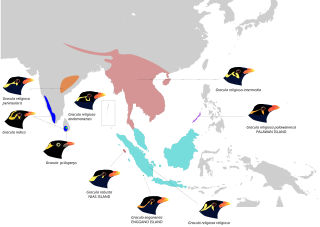
Gracula is a genus of mynas, tropical members of the starling family of birds found in southern Asia and introduced to Florida in the United States.

The Indian blackbird is a member of the thrush family Turdidae. It was formerly considered a subspecies of the common blackbird. It is found only in India and Sri Lanka. The subspecies from most of the Indian subcontinent, simillimus, nigropileus, bourdilloni and spencei, are small, only 19–20 centimetres long, and have broad eye-rings. They also differ in proportions, wing formula, egg colour and voice from the common blackbird.

The Sri Lanka thrush or Sri Lanka scaly thrush is a member of the thrush family Turdidae. This bird is a non-migratory resident breeder found in south western rainforests of the island of Sri Lanka.

The Nilgiri thrush is a member of the thrush family.




















